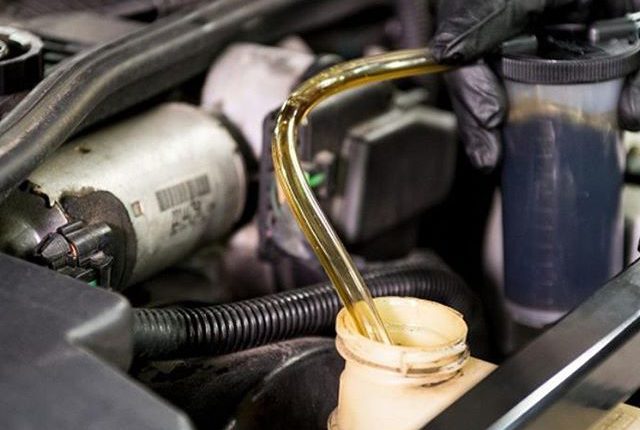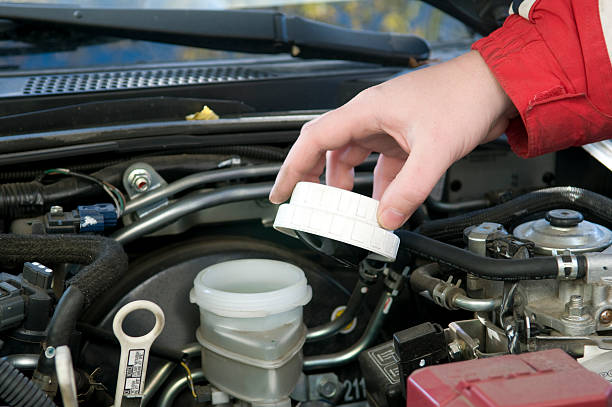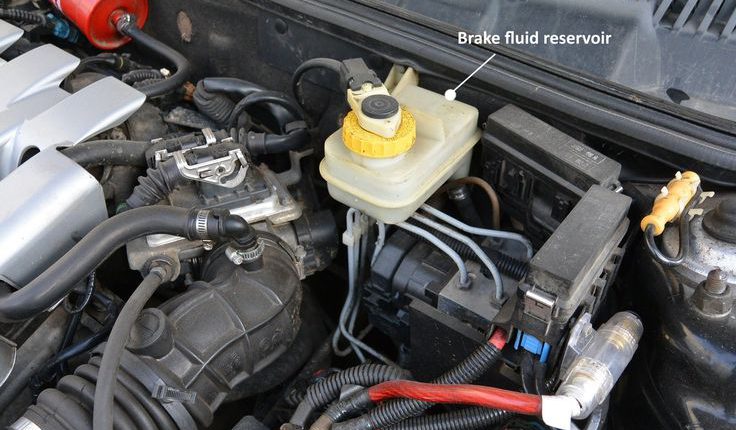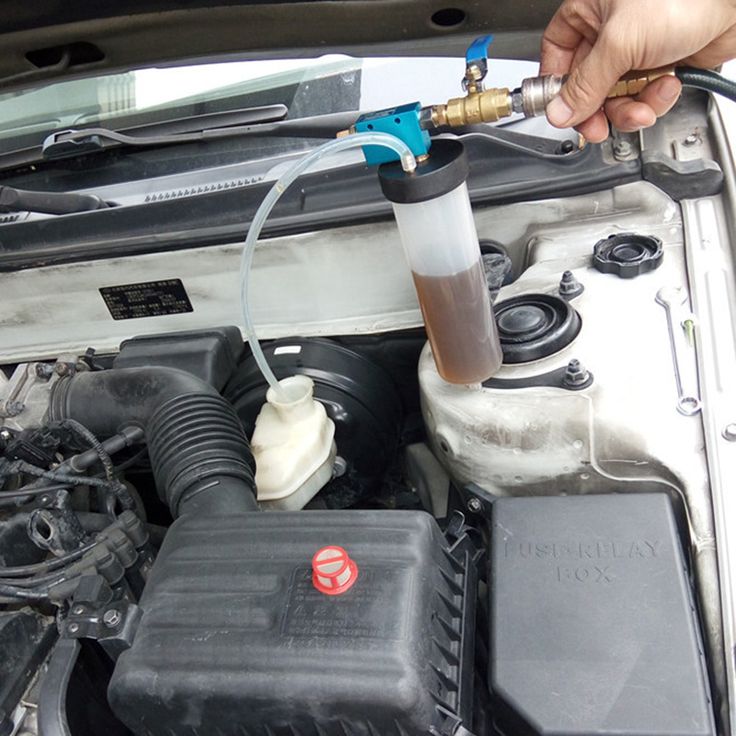Do you know that brake fluid colors are important signs that can tell you a lot about the condition of your vehicle? Many motorists become worried when noticing the brake fluid turn black or dark. What does it mean if the brake fluid is black? Let’s take a look at our article to know the reasons behind this problem.
Contents
Why Are Brake Fluids Necessary For Your Car?
According to statistics, for every 16,000 – 25,000 km, the driver will step on the brake more than 75,000 times. This number proved the importance of the brake system in your car. Therefore, to ensure that the brake system works effectively, it is essential to check and maintain the car’s brakes, especially by adding the car brake fluid.
Automotive brake fluid is a liquid formulated from highly refined base oils and multipurpose additives. This fluid is responsible for supporting the transmission of force from the brake pedal to the brake system components. Besides, brake fluid also has the important function of lubricating, preventing corrosion. And reducing friction which helps the brake system operate smoothly.
What Color Should Brake Fluid Be?
It can say that the brake fluid color is a vital indicator that tells you whether the brake fluid is in a good condition or needs to be changed. Black brake fluid can be a warning that your car has a problem. However, before determining if this is a normal phenomenon or not, you need to determine the color of the brake fluid. Currently, most brake fluids are manufactured according to DOT standards. This standard is determined based on the lowest boiling point and the brake fluid’s ability to maintain performance. There are 4 types of car brake fluid according to DOT standards: DOT 3, DOT 4, DOT 5, and DOT 5.1. DOT 3 and DOT 4 are the two most common types. Depending on the type of brake fluid your car is using, the colors will vary, specifically:
- DOT 4 and DOT 5.1 come in yellow color.
- DOT 3: this type of fluid is only used for racing cars. DOT 3 is blue.
- DOT 5: This fluid has a purple color.
However, all you need to remember is that the healthy brake fluid will come in nearly clear with a yellow tint. This color should look like the color in the bottle before you initially pour it into the car’s tank.

The Brake Fluid Is Black: What Does It Mean?
If you open the car’s brake fluid reservoir and you notice black or brown fluid. So what happened to your car? We’re sorry to say that black brake fluid is a sign that your fluid is highly contaminated. When this happens, the braking system’s ability to pressurize is reduced and brake performance may be affected. Besides, black brake fluid means that the rubber gasket has deteriorated and the liquid in the tank is too old and needs to be replaced. In fact, it turns out that brake fluid contaminants are attacking the rubber seals and washers. The black color in the liquid is the carbon particles from the rubber pads.
Why does brake fluid turn black?
Many drivers said that black brake fluid is caused by its age. It’s a true opinion. Like other fluids, the brake fluid will degrade after a long period and it needs to be replaced. After a while, your brake fluid will accumulate enough contaminants and cause the color to begin to change. This changeover will change from clear/yellow to a darker yellow, and when brake fluid is brown or black, this can seriously affect the braking system.
Inside the brake system is the brake fluid tank. From this reservoir, brake fluid travels its way from the cylinder to the car’s wheels. If you frequently step on the brake, the brake fluid will get contaminated faster. And even if you don’t drive as hard, as its feature, your brake fluid will still build up contaminants over time.
The second cause of discoloration in brake fluid is the deterioration of some parts in the brake system such as rubber brake lines, the gasket on the auxiliary cylinder, or the wheel. Because brake fluid is corrosive. Even though brake system components are designed to resist such corrosion. If not serviced or cared for properly, these parts will show signs of wear and tear. At this time, the microscopic pieces and soot of the rubber will follow the path to penetrate into the brake fluid. Discoloration as well as reducing the effectiveness of the fluid.
Why is the brake fluid easily contaminated?

Although the brake is a sealed system, steam can still get through the micro-holes in the rubber hose and sealing ring. Meanwhile, car brake fluid is easy to boil due to its high ability to absorb moisture, causing brake pressure to decrease and braking efficiency to be poor.
In addition, in countries with humid weather. The details in the brake system are also prone to rust when the brake fluid “saturates” water when the vehicle moves in rainy or flooded weather. In addition, the lack of brake fluid or degraded oil is the cause of brake system damage such as strange noises, low pedals, heavy braking feeling and the most extreme is the phenomenon of the car losing the brakes…
According to automotive experts, brake fluid contains corrosion inhibitors and antioxidants. Over time, the structure of these substances breaks down, leading to metal corrosion and the accumulation of deposits that disrupt the flow of brake fluid.
>>Read more: Brake Fluid Leak: Top Causes and Symptoms to Know!
Can You Drive When Brake Fluid Is Black?
Black brake fluid is absolutely not a good sign. This color indicates that there’s probably moisture that has infiltrated into your fluid and dramatically the quality of the fluid. The main function of brake fluid is to make your brake fluid operate more smoothly. What will happen if the brake fluid loses this feature? So this is the reason why many experts don’t recommend driving your vehicle with black fluid. Although black brake fluid does not always cause an alarm, using black fluid can cause serious issues.
This fluid content can corrode the steel components of your brake system and ruin them. Brake fluid used for a long time without replacing will cause the wheel cylinders to corrode; the foot pedal brake is not effective; brake pads are quickly damaged… Many parts and components are worn out and damaged affecting the entire brake system and vehicle; even your own driving.
In addition, the boiling point of contaminated brake fluid will be lower than that of clean brake fluid, thus reducing braking efficiency. When driving, the use of brakes generates a large amount of heat. Therefore, traveling with dirty brake fluid, when the fluid boils, creates a large amount of foam and gas. For a long time, car brakes are damaged. This is very dangerous when you are driving on the road.
How Often Should You Replace The Brake Fluid?
The brake fluid can be contaminated with 2% water within the first 12 months and increase to 7 – 8% after only 36 months. If you don’t change the fluid in time, it can lead to damage to the brake system during operation.
According to the manufacturer’s recommendations, the brake fluid needs to be changed every 3 years or after 30,000 – 40,000 miles. If the vehicle is constantly moving in dusty, high-humidity conditions or using the brakes continuously. The car owner can change the brake fluid earlier.
After that, you should take your car to the mechanic for repair to make sure everything is safe. To know exactly when to change brake fluid, car owners can check the actual amount and quality of oil in the tank through the brake fluid sensor equipped on the vehicle or check it manually. In the case of manual inspection, only observe from the outside. Do not open the lid to avoid air and moisture entering. The color will reflect the oil quality. Standard brake fluid is light or colorless if it turns brown. It means that the oil has deteriorated heavily and needs to be replaced to protect the brake system.
>> Related post: Low Brake Fluid: What A Mistake!
Steps To Change Car Brake Fluid

When checking, if the oil level is low but the color is clear or yellow. The car owner just needs to add more oil to the tank. The brake fluid needs to be replaced when it shows dirt or turns dark brown. Basic tools for changing brake fluid include a vacuum system, car repair kit, car jack, brake cleaning spray, and grease for bolts and screws.
Step 1:
Remove the wheel, and clean the car brake with a specialized cleaning solution.
Step 2:
Find the position of the top of the fluid pipe, and remove the rubber knobs that cover the outside of the pipe. Proceed to place a plastic tube in the reservoir and open the drain valve to let the old fluid out. This method minimizes air being drawn back into the brake cylinder.
Step 3:
Insert a piece of wood so that the brake pedal does not come off far when the oil pressure is released.
Step 4:
Open the brake fluid reservoir cap, use a straw to suck out all the old oil, pour in new oil and close the tank cap tightly.
Step 5:
Hold the brake with steady force, tighten the drain valve bolt and then loosen ¼ turn to drain all the old oil. Then, re-tighten the bolts, remove the plastic tube and install the rubber-coated knobs as before.
After completing the brake fluid change steps, the car owner starts the engine, presses, and releases the brake pedal to check the stability of the brake system.
As the “lifeblood” of the hydraulic brake system. Brake fluid should be periodically maintained and replaced to limit brake degradation and prevent operating risks.
To maximize power transmission efficiency, car owners should choose an uncompressed brake fluid that can lubricate the brake calipers to help reduce corrosion and high boiling points. It is recommended to use specialized brake fluid specific to each vehicle model according to the manufacturer’s recommendations. This not only helps to maximize the effectiveness of the car brake fluid but also ensures the life of the brake system.



